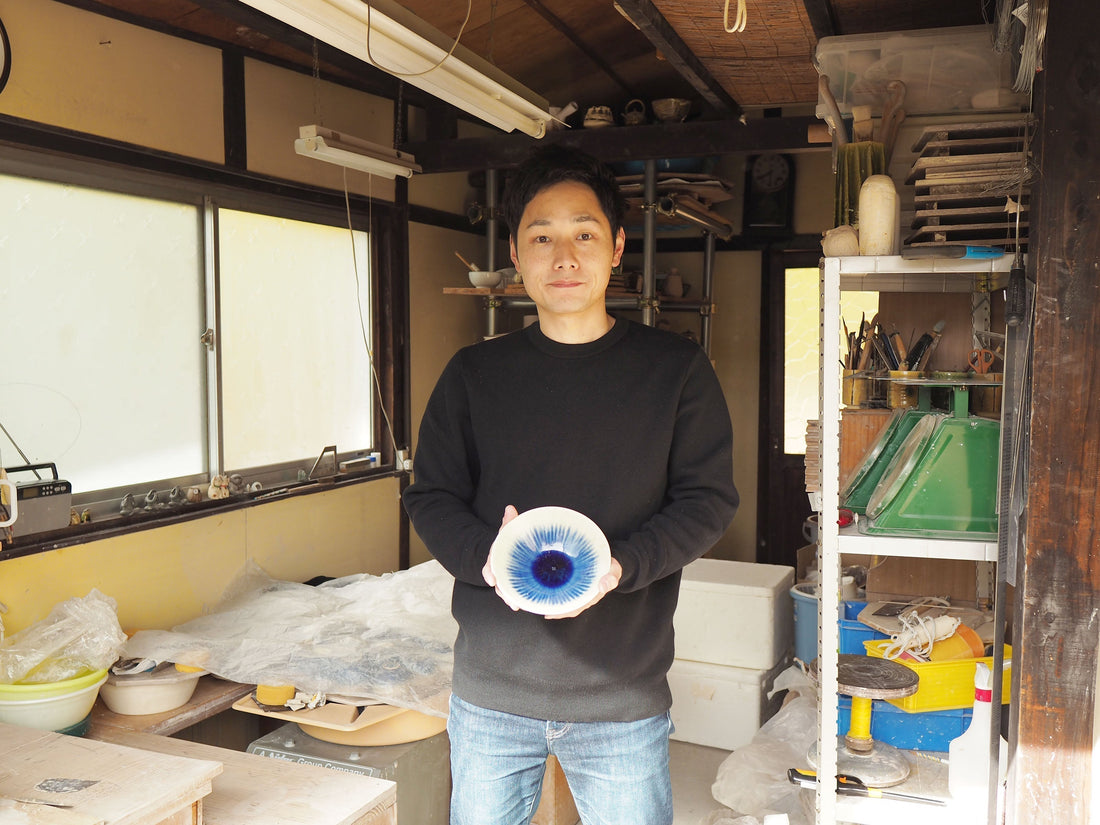
Interview with Yutaka Kato
23 years of experience in pottery, 36 years since first encountering pottery. Connecting rich hearts through pottery
Profile/Ceramics history
(Kato Yutaka)
He has 23 years of experience in pottery, and first encountered it 36 years ago. He studied under Living National Treasure Takuo Kato and spent seven years training at Kobei Kiln, a 210-year-old kiln. He has received the Tono Kinko Prize for Tokai Traditional Crafts and been selected for 15 public exhibitions. He has exhibited at over 30 exhibitions and events. His concept is "rich hearts connected through pottery."
This interview took place on a weekend afternoon. Kato Yutaka is an artist who works as a company employee during the weekdays while also working as a potter, "wearing two pairs of shoes." Furthermore, as he spoke to us with his son, who attends nursery school, sitting on his lap, we could also see his fatherly side.
Encounter with pottery - an accumulation of experiences from childhood
Kato describes himself as a "pottery artist." His ceramics career spans 25 years, dating back to joining the pottery club in high school. As a child, he played with clay in his father's pottery studio, and has spent nearly 40 years working with clay. Since elementary school, Kato's dream was to become a potter, so pottery has always been a familiar presence.
After graduating from the Tajimi City Ceramic Design Institute, he was hired by Kobeigama , a historic pottery factory in Ichinokura, Tajimi City, Gifu Prefecture, where he spent seven fulfilling years learning the basic techniques of pottery, from overglaze painting to the potter's wheel, tatara molding, and kiln firing, alongside colleagues of various generations.

Confusion about the future of ceramics and a second challenge
However, when asked why he decided to change jobs, Kato said, "I couldn't see a future in the Mino ware industry at the time." Looking back, he said, "I thought there was a future if I just endured it..." and revealed that he was unsure whether to continue with pottery or switch to another industry.
So he decided to take up pottery again and enrolled in the specialized course at Gifu Prefectural Tajimi Technical High School . After learning scientific knowledge in the ceramic technology course, he switched to the pottery course at the recommendation of his mentor. His mentor, known as a master of the potter's wheel, told him, "It would be a waste not to pursue pottery when you already have all this skill," and these words had a major impact on the rest of his life.
The path to independence: inheriting the studio and establishing a style
After graduating from the specialist course, Kato chose to continue his ceramic art career while working as a company employee due to financial concerns. He installed a new gas kiln in his family's workshop, which he inherited from his father, and secured time to create pottery. He expanded his network through pottery events and association activities, and continued to enter public exhibitions, winning numerous awards.
However, he says that he was unsure about his own style for many years. In his pursuit of originality, there was a period when he stopped making Oribe pieces. "Honestly, I didn't want to make anything," he says, looking back on that time, and says that if there hadn't been a deadline for submitting entries to the public exhibition, he might have quit pottery.
It was during this time, with the advice of his mentor and through repeated trial and error, that he created "Ransai."

The birth of the unique expression "Aisai"
"If we have Oribe's green, what about blue?"
Kato explored color by gradually changing the glaze mixture, just as if developing a cooking recipe. After much trial and error, he created a one-of-a-kind piece with a clear indigo line running down the inside of a white vessel. Glaze materials are lined up in his studio, and test pieces recording the subtle differences in color are posted on the wall.
Kato also has absolute confidence in his wheel-throwing techniques. "When I create the ideal shape, I feel like the clay is stretching out smoothly," he says. He has incorporated a "freshness" and "invigoration" into his pottery, like the flow of river water. He hopes that those who pick up his pottery will be able to feel the artist's sensibility and the charm of the materials.

Awards and solo exhibitions: A steady path as a ceramic artist
Even though he has a family and has limited time to create pottery, he won the Tono Shinkin Bank Award at the Tokai Traditional Crafts Exhibition in 2022. This award served as "proof that his style was recognized" and motivated him to take on his next challenge.
Furthermore, in a few months, he will be holding his first solo exhibition. Encouraged by his mentor's words , "You have to try doing a solo exhibition at least once," he is preparing for the exhibition by adding new works to his existing works. Although he laughs wryly and says, "I want to make more, but I can't find the time," his passion for pottery is endless.

As a father and a potter - a vision for the future
"It's better to create art when you're in a good mood."
Kato says, "The presence of his son working with clay beside him is an important time that adds color to his creative work. Just as he himself used to play with clay in his father's workshop, perhaps his son also senses something from watching his father quietly turn the potter's wheel."
Kato Yutaka is a potter, a company employee, and a father, all three of his roles. We look forward to seeing him achieve even greater success in the future.
(January 2025, Interview: Chika Shimura)




